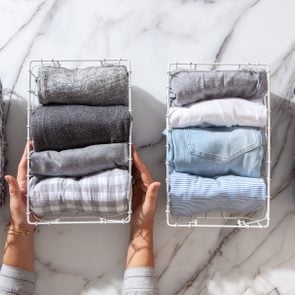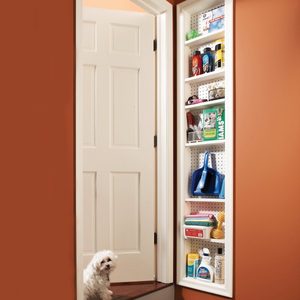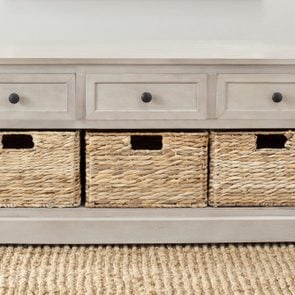21 Best Tips for Organized Kitchen Counters That Will Keep Even the Messiest Space Tidy
Updated: Mar. 12, 2024
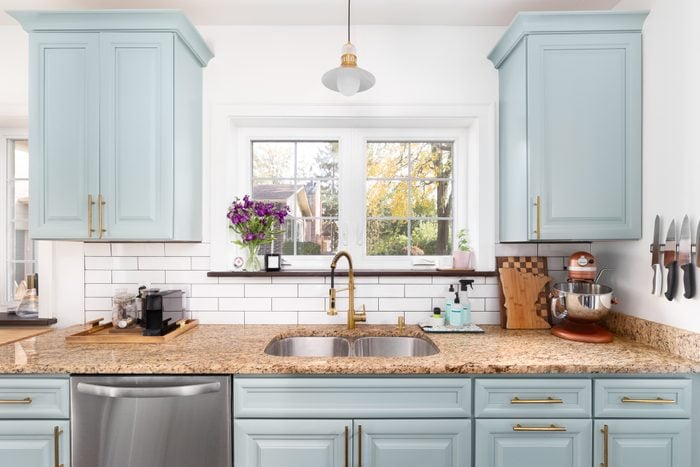
Here’s how to create perfectly organized kitchen counters and keep them clutter-free every day—with minimal effort
Yes, the kitchen is the heart of the home, but why does it always have to be so messy? That’s the question most of us ask when cluttered counters need to be cleared before homework and dinner prep can even begin. I have been tackling kitchen organization for decades, working in and from a wide variety of spaces, including urban pass-throughs, suburban standards and, for many years, a cottage galley with a nook. Kitchen counters are notorious magnets for gloves, groceries, dog leashes, mail and keys, to name a few, but having (and maintaining) organized kitchen counters isn’t an impossible dream.
The secret? It takes twin efforts of planning and vigilance to organize kitchen counters and keep them that way. Setting aside an afternoon to rethink some kitchen storage ideas will put you on the right path, whether you have a small kitchen or a spacious one. And once your plan is set, all you’ll need is minutes a day (and maybe a little family prompting) to maintain function and beauty in the most important room in your house.
Get Reader’s Digest’s Read Up newsletter for more organization tips, cleaning, travel, tech, humor and fun facts all week long.
Declutter
The first step in realizing your dream of organized kitchen counters? Assess what is actually on the counters. Is it mail and paperwork? Cooking utensils? Device chargers? Loads of appliances? We all have our pain points—the key is to recognize and acknowledge them.
Then, start to assemble piles by category, remembering that some items have less business in the kitchen than others. (More on that in a minute.) And toss catalogs that are gathering dust. Remember: Those retailers live online, so you don’t need to give those a second thought! Gather food-related items for further assessment, and if opportunity allows, create a designated pantry. Consider all options for separate food storage, including retrofitting a broom closet or adding a stand-alone cabinet.
Decide on counter essentials
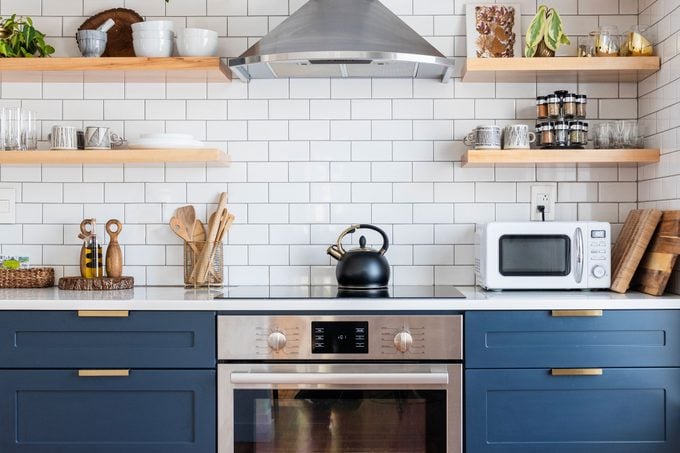
Not everything needs to live on the kitchen counter itself: If you don’t use it every day, put it away. For appliances, that means items like the waffle maker and popcorn machine. An air fryer can stay if you use it frequently, and coffee lovers should definitely keep their machine of choice handy. (For efficiency, keep the latter near a plug and sink.) Toasters should generally stay on the countertop too, since you won’t want crumbs in your cabinets. But to that end, keep your toaster and other appliances clean—and bonus points for coordinating the colors and styles of your appliances!
Next up: kitchen tools. Place regularly used spoons and spatulas in a utensil crock near the stove; store the rest neatly in a drawer with an organizer.
It’s fine to keep some oils, sauces and salts on the counter, but contain them on a tray or lazy Susan. (That’s also a great way to keep drips at bay.) Putting them near the stove and/or prep area makes the most sense, but be aware oils are heat- and light-sensitive, so they shouldn’t live too close to the stovetop or window.
Purge paperwork
The counter often becomes the drop zone for mail, invitations, permission slips and other random bits of paper. Start by sifting mail on the way from the box, so junk mail can be recycled before you even walk through the door. A desk with a filing system or individual baskets near an entrance can function as a new collection area, or consider redirecting these items to a home office. Whichever system you choose, make sure to add labels for each family member on those files, then drop items in the appropriate slots.
And to ensure you don’t miss important events, hang invitations inside cabinet doors, alongside a family calendar.
Create a work triangle
Ideally, every kitchen should have one of these. A traditional work triangle is the area between the refrigerator, sink and stove. Not every kitchen has this exact geometry, but you can make up for this by organizing areas by use. Professional chefs know that organized kitchen counters are about so much more than just having an attractive space—the goal should be efficiency of movement to cook and clean faster, and you can easily recreate their perfect setup at home.
The key? Organize counter items adjacent to where you will use them, but still focus on what you need most days. Here’s a handy cheat sheet:
- That utensil container filled with wooden spoons, ladles and spatulas, which we mentioned above, should reside near the stove.
- Knives should live close to cutting boards and the prep area.
- Daily dishwashing and cleaning supplies should be stored near or beneath the sink.
- Cleaning items that you use weekly can go with them if space allows, but you can also put them in a separate utility closet if not. Pro tip: While you’re reorganizing this space, purge unused cleaning products.
Find a home for everything
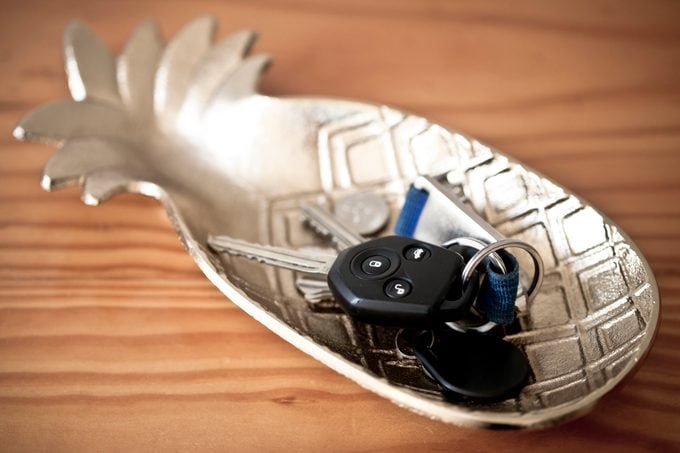
It’s all too easy to leave something and plan to take care of it later. It’s also pretty simple for multiple people in the house to do that simultaneously. By day’s end, the counter is jammed with junk, and no one person to blame. To fix this, focus on what regularly lands on the counter and figure out a solution for those items. If it’s damp dish towels, look for a place to hang a small rack near the sink. For families with small children, clean cups and bottles can stay on the counter if they’re collected in a basket. House and car keys can go in a designated bowl.
That said, we do live in the real world, which means we all have junk drawers. That’s OK! Just organize them! Separate the smaller items like wine openers and screwdrivers by category, and outfit the drawer with an organizer to make everything easier to find.
Create a makeshift closet
Why do shoes, jackets and mittens always land in the kitchen? Anyone … anyone … Bueller … Bueller? Just kidding—this is a rhetorical question, of course. Still, you can have elements of a mud room even if you don’t have an entire room to dedicate to one. Hang hooks by the door for dog leashes, or install a peg rack (or racks) to help with coats, bags and hats. Add a boot tray for muddy shoes. To make sure everyone does what they’re supposed to, institute a “no snacking before hanging” rule.
Fashion your own coffee bar
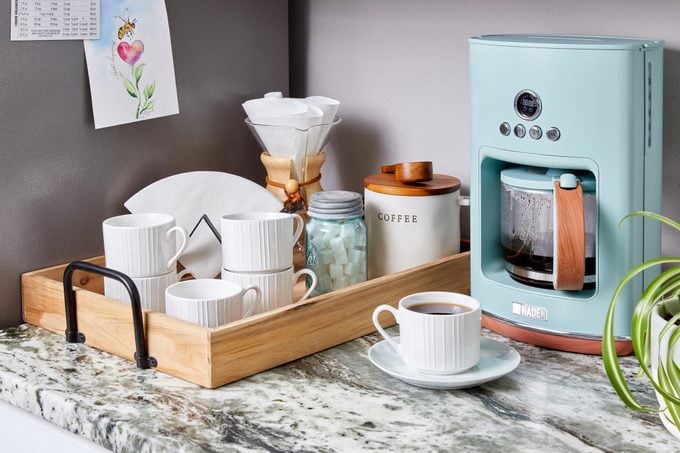
This kitchen counter organization idea is for Instagram and a better morning. Collect cute cups, spoons and coffee essentials in a flat-bottomed basket or on a coordinating tray near the coffee maker. Include options for any tea lovers in the house. It will look like a bed and breakfast landed in your kitchen! You can also set up something similar for wine service or your favorite cocktails.
Expand the kitchen
Organized kitchen counters stay organized if you keep their main focus as food-prep and serving spaces. But what do you do with all your stuff? Consider other spots in the kitchen, as well as adjacent rooms, for non-food related items. A nearby wall can offer space for an organizing console, bookcase or small desk. Gather cookbooks on kitchen-adjacent shelving. Ditto for electronics.
And regardless of whether you end up doing your paperwork in the kitchen or office, create a simple system that family members of all ages can use. Add folders or a mail tray with labeling, such as “current bills,” “paid invoices,” “permission slips” or “homework.” Kids love routines, so definitely give them one for filing. If you’re worried that out of sight means out of mind, add a weekly appointment for paperwork to your calendar.
To retrain the family (and yourself), leave a reminder sign on the counter for a while, redirecting paperwork to its proper spots. No judgment—visual cues work!
Add a pot rack

Even the best-planned kitchens might lack storage for pots and pans. A pot rack can easily solve this problem. If wall space is insufficient, look (even further) up. The ceiling is considered the fifth wall in design, so why not use it to clear the counter?
Store knives effectively
With space at a premium, rethink the knife block. Removing it will free up counter space, and there are other options that keep knives handy. For example, you can mount a magnetic knife strip on the wall for easy access. A drawer with a protective knife organizer offers another solution.
Install a spice shelf
Look for wall space near the prep area for a simple rack to gather spices. Your collection can be decanted into matching containers for a sleek and super organized look. If one shelf doesn’t offer enough storage, double down and add another. Some are multi-tiered, so they can add counter space while offering an attractive way to keep multiple bottles contained near a prep area. Just try to protect sensitive ingredients by keeping them away from heat.
Other options: Mount a rack on the interior of a cabinet door. Or use a spice organizer made specifically for drawers.
Hang a pegboard
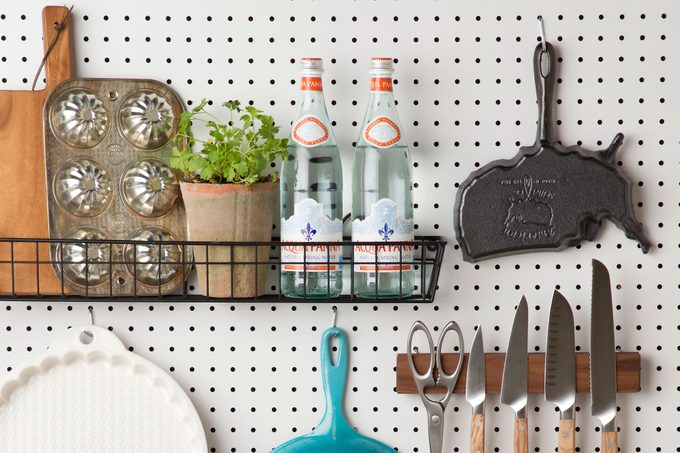
Channel your inner Julia Child. The queen of the kitchen famously used a pegboard to hold her sizable collection of pots and pans with outlines for easy rehanging. That concept can work for you too, particularly if storage is in short supply. A traditional pegboard can even be painted to coordinate with your kitchen, and you can install it as a backsplash or on a free wall.
You also don’t have to limit yourself to pots and pans—you can use a peg board to hang measuring cups, spatulas and graters as well. Some more sophisticated systems even mix hooks and shelves for glassware, coffee cups and condiments.
Make friends with the end caps
You probably normally ignore the side of a cabinet, but you shouldn’t! This unused vertical space can offer a clean slate for hanging tools, dish towels and cooking equipment. Shelving can also be added to hold smaller items, and the exposed end of lower cabinets can be the perfect place to add a shelving unit that holds cookbooks. Don’t want to drill into your cabinets? Look for removable options.
Organize kitchen cabinets
No counter lives in isolation. If too many things are accumulating, it’s time for a deep dive into kitchen cabinet organizing. Trash the broken items. Donate the mismatched. Regift the unused. Seriously, a decades-old, nearly new mandoline is occupying valuable space—and if you haven’t used it by now, you’re not going to start. (Sorry, but it’s true!)
Removing the unused and reorganizing what’s left with vertical dividers and other space-saving tools can open the door for things that live on counters by default, like multiple cutting boards and the pressure cooker. For safety’s sake, store larger appliances below and lighter items (like glassware) above.
Reorganize under the sink
Despite its inconveniently curving pipes, under-the-sink storage is a godsend that can help you clear your counters. Sliding shelves or stacked shelving can double space for storing cleaning products, and a door caddy works for smaller supplies, such as sponges and scrub brushes.
Add a riser
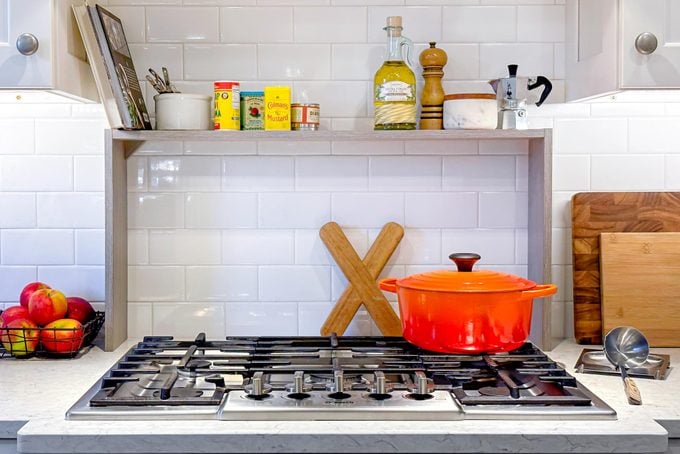
A counter riser can elevate items so you have space for them—and then more space for other stuff underneath. What’s more, this kitchen organization tool doesn’t require any installation. All you have to do is buy one, place it on your countertop and let it work its magic. Use the upper tier to hold oils, salt and pepper, and place mugs and sugar below. Risers can work inside cabinets too. Simply store bottles above and boxes of food below, or stack cans with the labels facing outward so they’re easy to identify.
Embrace vertical storage
Stay on trend with your organized kitchen counters by stacking cutting boards in an upright position against a wall. The mix of materials and sizes is visually inviting, plus this setup makes them readily accessible for chopping veggies and crafting charcuterie boards. Place the largest in back and smallest in front. Vertical racks offer another way to gather and prop boards.
Invest in a lazy Susan … or two
The lazy Susan is genius for keeping like items contained and accessible. A spinning tray can hold bottles of olive oil and vinegar, a mister, salt and pepper, and whatever else you need on a daily basis. It has the added benefit of preventing oil and acid drips from hitting the counter too. A lazy Susan with compartments also makes a handy snack bin on the counter or in the pantry.
Think about an island
Not every kitchen comes with an island, but that workhorse can help you organize your kitchen counters, not to mention provide extra prep space. Sometimes replacing your existing one makes sense too, budget permitting. It can add cabinets and shelving, or give you a place to stash a microwave, expanding your kitchen subtly but exponentially.
If you don’t have an island yet, think about what you’d like it to do. Obviously, adding counter space for prepping or seating is a gift. But beyond that, do you want open shelving for mixing bowls, baking equipment and books? Would a closed cabinet help hide roasting pans and baking sheets? Also, think about a stationary island versus a mobile one, and invest in a unit with a style that coordinates with your kitchen. If budget or space doesn’t allow for a big footprint, look for a smaller island on wheels that can be tucked against a cabinet or in a corner when not in use.
Manage cords
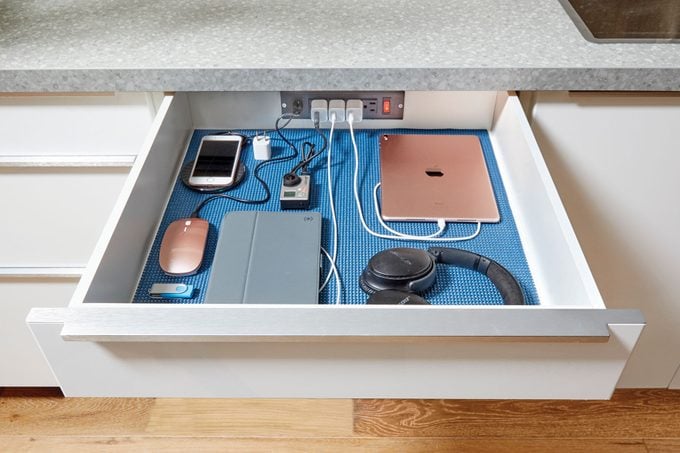
Consider alternative solutions for that unsightly nest of charging cords. At minimum, contain them in an attractive basket. Better yet, ask an electrician to install an outlet strip inside a drawer. Out of sight, out of mess. Or relocate your chargers entirely. A nearby room might have more space for a dedicated charging station.
Change your habits
Stick to a nightly routine for kitchen cleaning and care. It might be the last thing on your agenda when you’re exhausted and just want to relax, but a few minutes at the end of each day will create a sense of order and make tomorrow so much better. Here are the tasks that should be at the top of your list for maintaining well-organized kitchen counters:
- Wash and put away dishes.
- Throw away or file excess papers.
- Return kitchen items to their rightful places.
- Give countertops and appliances a quick swipe with a sponge or paper towel.
Miss a night? Don’t get discouraged. Establishing a new habit might take months, but research suggests that lapsing a day or even two won’t hinder your progress if you keep at it.

